
The Stroganov Palace, also known as the Stroganov Palace, is a historic building and one of the palaces located in the center of St. Petersburg.
Today, the Stroganov Palace is part of the architectural complex of the State Russian Museum. Some of the museum's collections are displayed within its walls and temporary (rotating) exhibitions are held.
Stroganov Palace is one of the most impressive buildings in the center of St. Petersburg, as well as a monument of Baroque architecture.
The formation of the palace began in the 1720s, when one-story chambers belonging to the Stroganov family were built near the Green Bridge over the Moika River. Later, Baron S. G. Stroganov bought an unfinished two-story house here.
As a palace, the Stroganov estate was built in 1753-1754, when the architect of Italian origin Francesco Bartolomeo Rastrelli united the Stroganov houses into a single whole with a common facade belonging to the Baroque style.
The main interiors of the palace were also made in the Baroque style.
The palace had the shape of the letter " G " and a courtyard. Initially, the entrance to the palace was carried out from the main courtyard, but in the late 18th and early 19th centuries, Andrei Voronikhin arranged an entrance from Nevsky Prospekt, which still exists today. The architect also reconstructed and re-created a number of interiors in the classical style, including the newly added eastern building. The eastern building was intended mainly to house the art collections of Count A. S. Stroganov. In 1842, Peter Sadovnikov completed the formation of the southern building of the palace and stylistically combined all the courtyard facades in the "Rastrelli spirit".
Over the course of history, the interiors of the palace have changed.
After the revolution, in 1918, the Stroganov Palace was nationalized and turned into the"People's House-Museum (formerly Stroganov)".
From 1929 to 1988, the building changed owners, including the All - Union Lenin Academy of Agricultural Sciences, and the Stroganov art collections were distributed to various museums in the country and some of them were sold abroad.
Since 1988, the building has been transferred to the Russian Museum. Subsequently, the museum carried out restoration work to restore the facades and interiors of the palace.
Today, the Stroganov Palace in the plan forms a square, in the center of which there is a patio.
The main facades of the palace (north and west) overlook Nevsky Prospekt and the Moika River embankment. Both facades have similar architectural compositions.
In the center, each of the facades is decorated with an unusual portico, on the pediment of which is placed the Stroganov coat of arms, crowned with a baronial crown.
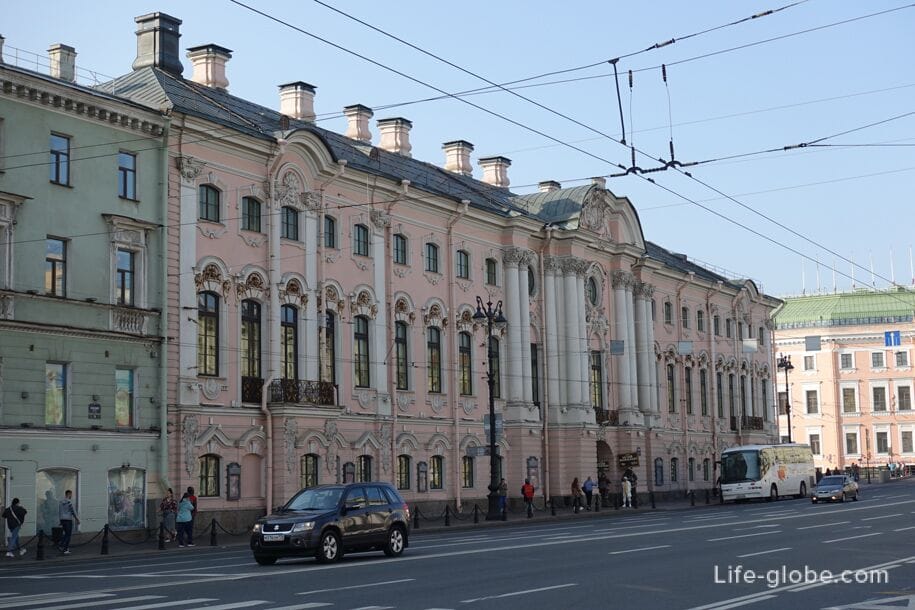

Russian Russian Museum-the world's largest museum of Russian art, whose collections are located in several historical buildings, together representing a unique architectural and artistic complex in the historical center of St. Petersburg. Learn more about the Russian Museum...
In the walls of the Stroganov Palace, you can see some of the restored rooms and halls of the palace.
The palace also displays the museum's collections, including:
- exhibition " Russian Empire. Decorative and applied art of the time of the reign of Emperor Alexander I (1801-1825)" which presents porcelain products, tableware, vases, etc.;
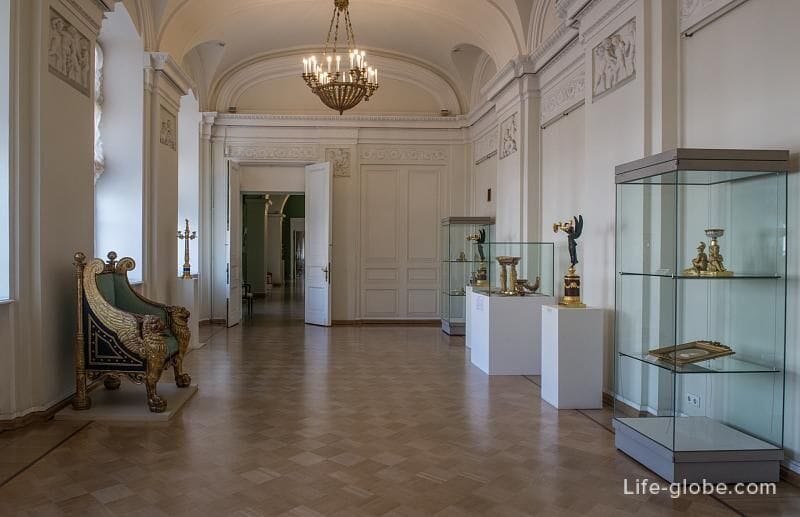
- "Mineralogical Cabinet", which was made by A. Voronikhin in 1791-1792 and is considered one of the masterpieces of Russian architecture of the 18th century. Initially, the cabinet was intended to house the richest book collection of Count A. S. Stroganov and exhibit a collection of minerals.
Fluted columns of the Corinthian order, made of artificial marble, support the vaults on which the choirs of the second tier of the cabinet rest. The first tier is decorated with four allegorical bas-reliefs depicting the four elements: "Fire", "Water", "Earth" and "Air". The perspective painting of the dome of the room was executed in the early 19th century, presumably by P. Gonzago.
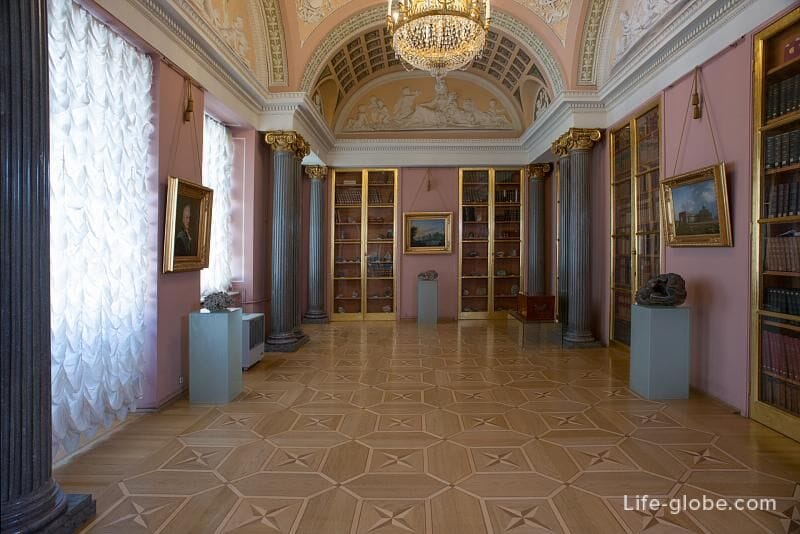
The Great Hall (or Rastrelli Hall), intended for balls and concerts.
The main attraction of the hall is a large plafond that occupies the entire surface of the ceiling. The ceiling was made in the 1750s by the Italian artist Giuseppe Valeriani. In the center of the composition of the plafond, the goddess of wisdom Minerva is depicted, striking vices, to the right of her are allegories of the arts, which were patronized by the Stroganovs, to the left-virtues.

The State Dining Room (or Corner Hall) was created in the 1750s by Andrey Voronikhin on the site of the Mirror Gallery.
In the interior of the room, large one-piece mirrors are used, which visually expand the room.

In the eastern building of the palace is locatedThe art gallery, considered one of the best works of Andrey Voronikhin and representing a unique Russian interior of the turn of the 18th and 19th centuries.
Numerous paintings, mostly by Western European masters, framed by a gilded baguette, occupy most of the plane of the gallery walls.
Along the walls are six sofas and fourteen armchairs upholstered in green silk. The furniture was restored by the Russian Museum.
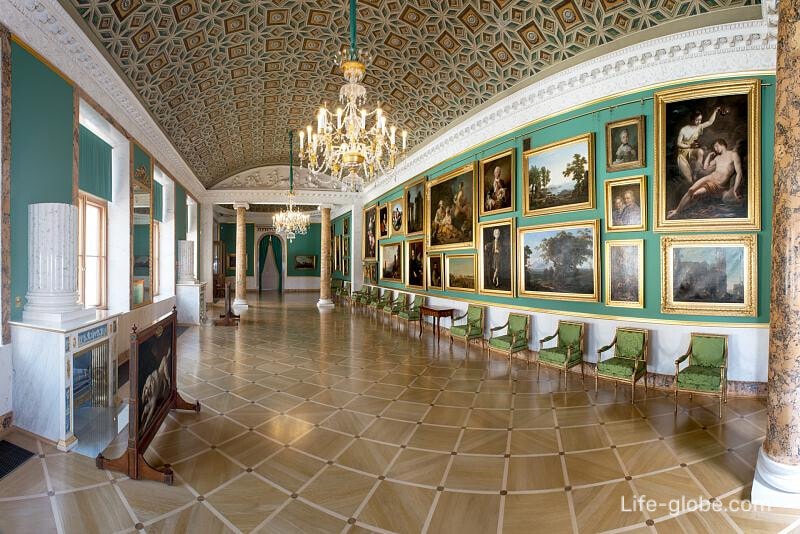
The small drawing room of the palace is a true example of Voronikhin's creativity. The interior of the living room has only minor later additions.
The large drawing room of the palace was restored by restorers in accordance with the period when it was decorated - the end of the 1850s. Presumably, the Large living room was decorated by the architect M. A. Makarov.

In the same years as the creation of the Large Living Room and, possibly, with the participation of the same architect, in the northern building of the palace appearedLarge and Small offices, as well as related informationThe Arabesque drawingroom, which was unusual for the mid-19th century and still exhibits copies of frescoes by Raphael's students for the so-called "Raphael Loggias".
Large office

Arabesque living room
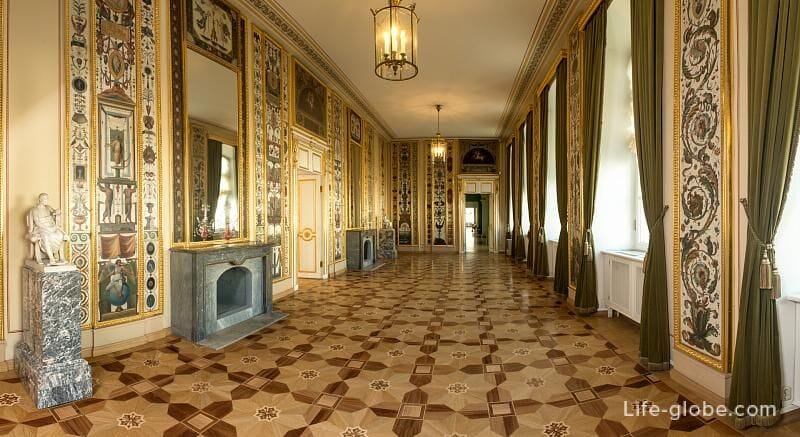
In the building of the Stroganov Palace there are also: a museum-a chocolate shop and a restaurant.
Stroganov Palace is located near the Green Bridge, at the intersection of Nevsky Prospekt and the Moika River embankment, at the address: Nevsky Prospekt, 17.
The nearest metrostations are Nevsky Prospekt and Admiralteiskaya.
Buses: №№ 3, 22, 27, 49, K212. Trolleybuses: №№ 5 and 22.
In addition to permanent exhibitions, temporary (rotating) exhibitions are also held within the walls of the Stroganov Palace.
At the Stroganov Palace information desk, you can learn about the museum's working hours, temporary exhibitions, events, lectures, classes and concerts held in the Russian Museum.
You can visit the museum in the Stroganov Palace by purchasing a separate ticket or a complex ticket for visiting the Stroganov Palace + other objects of the Russian Museum.
We recommend that you check all the necessary information, including the museum's working hours, ticket prices, exhibitions and events, before visiting the official website of the museum.
Website of the State Russian Museum: en.rusmuseum.
All accommodation facilities in St. Petersburg, including in the city center and more remote from it, can be viewed and booked here